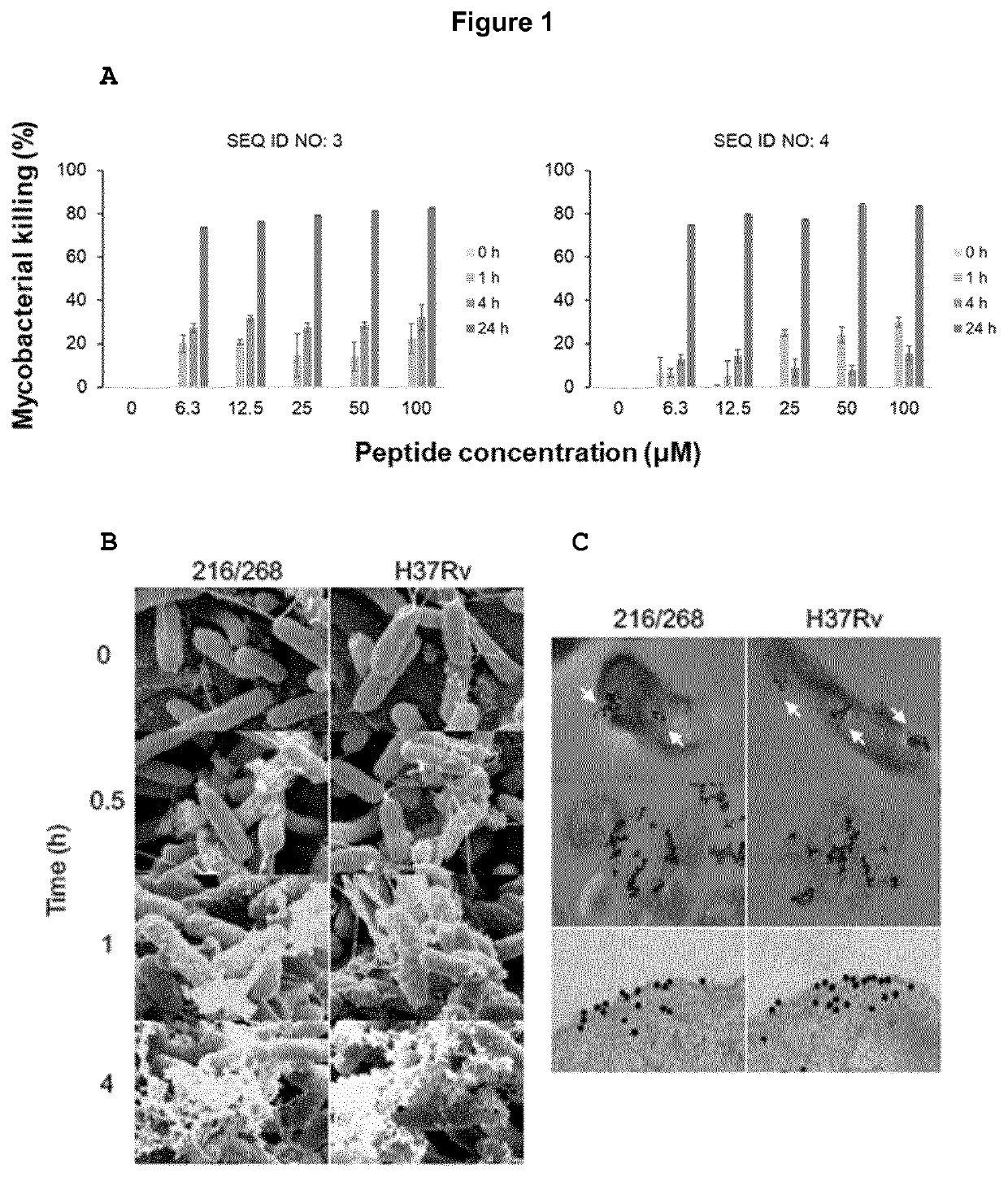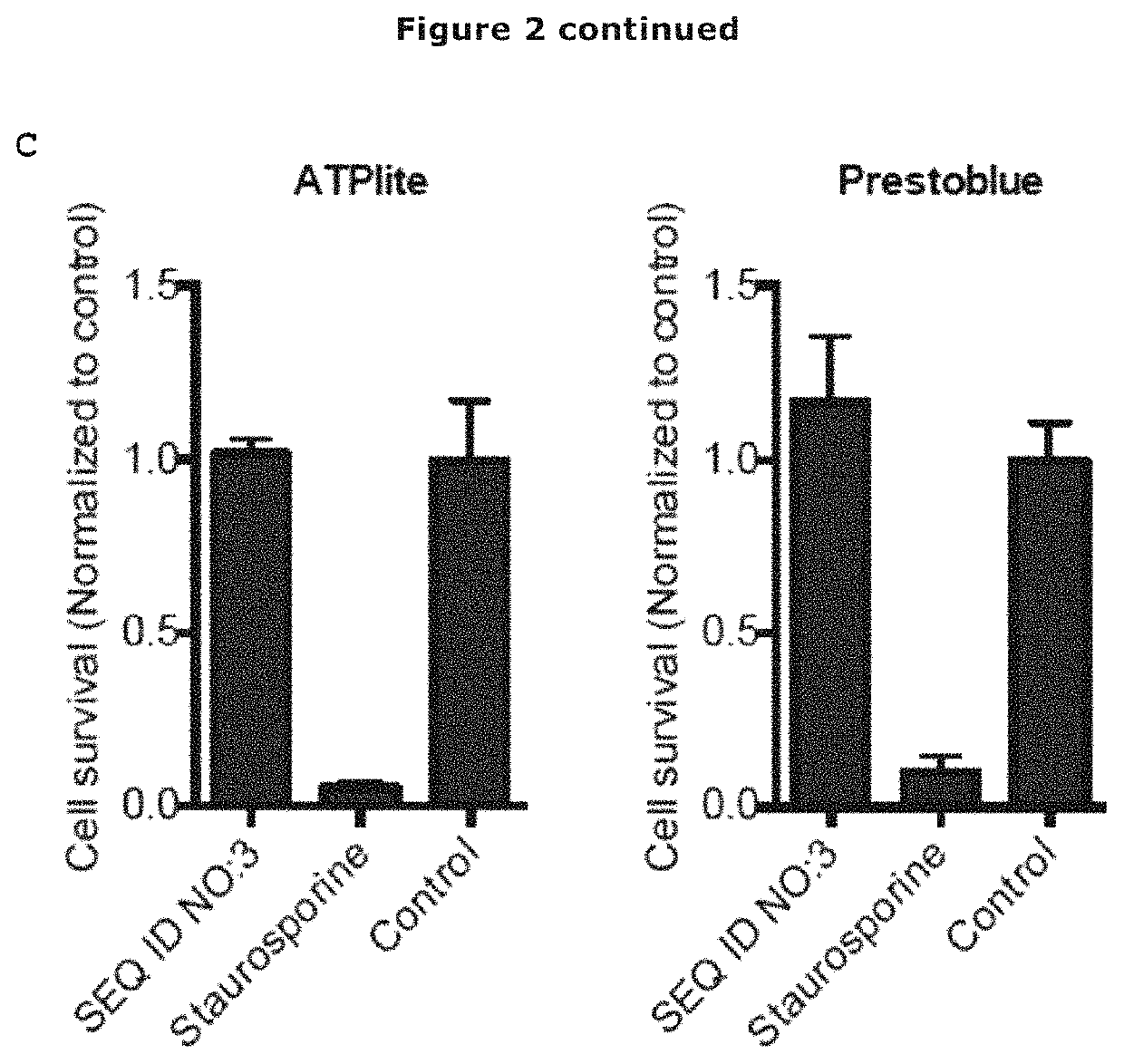Peptides with antibiotic potential against Mycobacterium tuberculosis
a technology of antibiotic potential and peptides, which is applied in the field of new drugs, can solve the problems of increasing the toxicity of mdr-tb therapy for patients, and increasing the cost and prolongation of treatment. , to achieve the effect of inhibiting hyperinflammation
- Summary
- Abstract
- Description
- Claims
- Application Information
AI Technical Summary
Benefits of technology
Problems solved by technology
Method used
Image
Examples
example 1
[0114]Variant Antimicrobial Peptides Kill M. tuberculosis
[0115]The variant antimicrobial peptide precursor, plectasin, contains a cysteine-stabilized α-helix / β-sheet motif (CSaβ) that interferes with peptidoglycan precursor to induce lysis. M. tuberculosis H37Rv and clinical isolate TB2016 / 268 were treated with up to 100 μM of variant antimicrobial peptides of SEQ ID NO: 3 and SEQ ID NO: 4. Results showed that variant antimicrobial peptide of SEQ ID NO: 3 resulted in Mycobacterial killing efficiency of 73.8%±(0.1), where as variant antimicrobial peptide of SEQ ID NO: 4 resulted in Mycobacterial killing efficiency of 74.8%±(0.1), both at 6.3 μM peptide concentration (FIG. 1A).
[0116]Scanning electron microscopy showed membrane disruption starting at 30 minutes (FIG. 1B). The median and range of MIC for the two strains were 6.3 μM (6.3-12.5) for H37Rv and 6.3 μM (3.1-6.3) for TB2016 / 268, respectively.
[0117]The variant antimicrobial peptide of SEQ ID NO: 3 inhibited the bacteria at con...
example 2
[0119]The Variant Antimicrobial Peptide Interferes with Mycobacterial Membrane
[0120]Plectasin was previously shown to interact differently with membranes compared to other AMPs, binding directly to the cell-wall precursor Lipid II (Schneider, T., et al. Science 328, 1168-1172 (2010). Lipid II is also a major constituent of cell-wall building block in mycobacterial spp, suggesting that the variant antimicrobial peptide of SEQ ID NO: 3, with 93% as similarity to plectasin, could possess a similar binding action. We labelled the variant antimicrobial peptide of SEQ ID NO: 3 with gold and studied with TEM. We observed that the variant antimicrobial peptide of SEQ ID NO: 3 associated with the mycobacterial envelope within one hour of exposure and disrupted bacterial membranes (FIG. 10).
example 3
[0121]The Variant Antimicrobial Peptide of SEQ ID NO: 3 is Resistant to Degradation by Proteases
[0122]A major barrier limiting the clinical application of AMPs is their susceptibility to protease degradation, such as the neutrophil elastase, in biological fluids. Also, bacteria produce a variety of proteases to protect themselves from peptides. To investigate whether the variant antimicrobial peptide of SEQ ID NO: 3 is degraded by proteases, the peptide was incubated with Human neutrophil elastase (HNE), Cathepsin G and human α-thrombin. Of the investigated proteases, only HNE showed peptide degradation, with approximately 50 breakdown after 22 hours (FIG. 2A).
PUM
| Property | Measurement | Unit |
|---|---|---|
| working distance | aaaaa | aaaaa |
| acceleration voltage | aaaaa | aaaaa |
| accelerating voltage | aaaaa | aaaaa |
Abstract
Description
Claims
Application Information
 Login to View More
Login to View More - R&D
- Intellectual Property
- Life Sciences
- Materials
- Tech Scout
- Unparalleled Data Quality
- Higher Quality Content
- 60% Fewer Hallucinations
Browse by: Latest US Patents, China's latest patents, Technical Efficacy Thesaurus, Application Domain, Technology Topic, Popular Technical Reports.
© 2025 PatSnap. All rights reserved.Legal|Privacy policy|Modern Slavery Act Transparency Statement|Sitemap|About US| Contact US: help@patsnap.com



